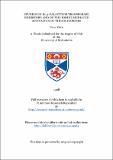Files in this item
Studies on β1,4-galactosyltransferase inhibitors and on the iodine mediated activation of thioglycosides
Item metadata
| dc.contributor.advisor | Field, Rob | |
| dc.contributor.author | Cura, Peter | |
| dc.coverage.spatial | 156 p. | en_US |
| dc.date.accessioned | 2018-06-21T10:05:31Z | |
| dc.date.available | 2018-06-21T10:05:31Z | |
| dc.date.issued | 1998 | |
| dc.identifier.uri | https://hdl.handle.net/10023/14384 | |
| dc.description.abstract | This abstract describes both parts of a two part thesis. Part 1 Potential acceptor substrate analogue inhibitors of beta-1,4-galactosyltransferase were proposed and the following compounds were thus synthesised to assist in understanding the mechanism of this enzyme. Octyl 2-acetamido-3,6-di-O- benzoyl-2-deoxy-beta-D-glucopyranoside (13) was synthesised and the 4-hydroxyl group was oxidised to give the corresponding ketone, octyl 2-acetamido-3,6-di-O-benzoyl-2-deoxy-beta-D-xylo-hexopyranosid-4-ulose (15). The ketone (15) was reacted with methoxylamine hydrochloride to give the O-methyloxime, octyl 2-acetamido-3,6-di-O-benzoyl-2,4-dideoxy-4-methoxyimino-beta-D-xylo- hexopyranosid-4-ulose (16), which was reduced to give both the gluco- and galacto-configured O-methylhydroxylamines, octyl 2-acetamido-3,6-di-O- benzoyl-2,4-dideoxy-4-methoxyimino-beta-D-glucopyranoside (17) and octyl 2- acetamido-3,6-di-O-benzoyl-2,4-dideoxy-4-methoxyamino-beta-D- galactopyranoside (18). Both methoxyamino compounds are, however, unstable and hence studies towards the target compounds via an amine at the 4-position were pursued. Octyl 2-acetamido-4-O-acetyl-3,6-di-O-benzyl-2-deoxy-beta-D- galactopyranoside (23) was prepared by displacement of the mesyl group of octyl 2-acetamido-3,6-di-O-benzyl-2-deoxy-4-O-methanesulfonyl-beta-D- glucopyranoside (22) with cesium acetate. Octyl 2-acetamido-3,6-di-O-benzyl-2- deoxy-4-O-methanesulfonyl-beta-D-galactopyranoside (25) was prepared from this and the mesyl group was displaced with sodium azide to give octyl 2-acetamido- 4-azido-3,6-di-O-benzyl-2,4-dideoxy-beta-D-glucopyranoside (26). Octyl 2- acetamido-3,6-di-O-benzoyl-2-deoxy-beta-D-glucopyranoside (13) was reacted with methanesulfonyl chloride to give octyl 2-acetamido-3,6-di-O-benzoyl-2-deoxy-4-O-methanesulfonyl-beta-D-glucopyranoside (28). The mesyl group was displaced with sodium azide to give the galacto-configured azide, octyl 2-acetamido-4- azido-3,6-di-O-benzoyl-2,4-dideoxy-beta-D-galactopyranoside (29). After reduction of the azide functionalities to the corresponding amines access to various amine derivatives will be possible. Part 2 To enable a better understanding of thioglycoside activation by iodine, the following beta-glycosides of 2,3,4,6-tetra-O-benzyl-D-galactopyranoside were synthesised: thiomethyl (39), thiobenzyl (48), thiophenyl (36), p-methoxythiophenyl (44), p-nitrothiophenyl (47) and p-acetamidothiophenyl (51). All of these compounds were treated with iodine in the presence of methanol and rates of reaction were compared. Reactivity was found to depend on the nature of the leaving group. Further studies showed that DDQ in combination with iodine gave rise to substantially enhanced rates of reaction. Similar experiments showed that the nature of the solvent also affected the rate of reaction with reaction in acetonitrile substantially faster than in dichloromethane. Further studies, replacing iodine with either IBr or ICl demonstrated that both of these reagents could activate thioglycosides more rapidly than iodine. All compounds tested can be activated in approximately 1 minute depending on the activator(s) and solvent used. The anomeric ratios of all reactions favoured formation of the methyl a-glycoside. The mechanism of these reactions was studied by analysing the reaction of methyl 2,3,4,6-tetra-O-benzyl-l-thio-beta-D-galactopyranoside (39) with iodine in the absence of methanol. This demonstrated that the thiomethyl glycoside anomerised rapidly; real time N.M.R. studies revealed that the course of the reaction could be followed by N.M.R.. An analogous study in the presence of methanol demonstrated that anomerisation also takes place simultaneously with the formation of O-methyl glycosides and can similarly be followed by N.M.R.. Activation and glycosylation of thioglycosides with iodine vapour was demonstrated on the surface of silica t.l.c. plates. It may therefore be possible to optimise reaction conditions on t.l.c. plates prior to use of significant quantities of reagents. | en_US |
| dc.language.iso | en | en_US |
| dc.publisher | University of St Andrews | |
| dc.subject.lcc | QP606.C9 | |
| dc.title | Studies on β1,4-galactosyltransferase inhibitors and on the iodine mediated activation of thioglycosides | en_US |
| dc.type | Thesis | en_US |
| dc.type.qualificationlevel | Doctoral | en_US |
| dc.type.qualificationname | PhD Doctor of Philosophy | en_US |
| dc.publisher.institution | The University of St Andrews | en_US |
This item appears in the following Collection(s)
Items in the St Andrews Research Repository are protected by copyright, with all rights reserved, unless otherwise indicated.

